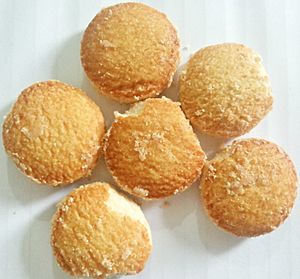Nankhatai facts for kids
 |
|
| Alternative names | Kulcha-e-Khataye |
|---|---|
| Type | Shortbread |
| Place of origin | India |
| Associated national cuisine | India, Bangladesh, Pakistan |
| Main ingredients | Wheat flour, Rice flour, Butter, Powdered Sugar, Milk/Yogurt, Salt, Honey, Baking Powder |
Nankhatai (Hindi: नानख़ताई, Urdu: نان خطائی) are shortbread biscuits, originating from the Indian subcontinent, popular in Northern India and Pakistan. The word Nankhatai is derived from the Persian word naan meaning bread and khatai from a Dari Persian word meaning biscuit. Khatai or more properly khitai (خطائی) means Chinese in Persian and Urdu, more specifically from northern China (Cathay in English, derived from Khitan peoples). In Afghanistan and Northeast Iran, these biscuits are called Kulcha-e-Khataye. Kulcha is a type of Indian (also Afghan and Persian) bread similar to Naan.
History
Nankhatai is believed to have originated in Surat in the 16th century, when Dutch and Indians were the important spice traders. A Dutch couple set up a bakery in Surat to meet the needs of local Dutch residents. When the Dutch left India, they handed over the bakery to an Iranian. The bakery biscuits were disliked by the locals. To save his business he started selling dried bread at low prices. It became so popular that he started drying the bread before selling it. With time, his experimentation with bread ultimately gave birth to nankhatai. The main ingredients in nankhatai are refined flour, chickpea flour and semolina.
See also
 In Spanish: Nankhatai para niños
In Spanish: Nankhatai para niños

